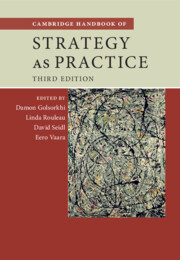Book contents
- Cambridge Handbook of Strategy as Practice
- Cambridge Handbook of Strategy as Practice
- Copyright page
- Contents
- Figures
- Tables
- Boxes
- Contributors
- Preface to the Third Edition
- Introduction: What Is Strategy as Practice?
- Part I Ontological and Epistemological Questions
- Part II Theoretical Resources: Social Theory
- Part III Theoretical Resources: Organization and Management Theories
- Chapter 17 An Institutional Perspective on Strategy as Practice
- Chapter 18 Identity Work as a Strategic Practice
- Chapter 19 Sensemaking in Strategy as Practice: From a Phenomenon towards a Theory?
- Chapter 20 Routine Dynamics and Connections to Strategy as Practice
- Chapter 21 The Communicative Constitution of Strategy-Making: Exploring Fleeting Moments of Strategy
- Chapter 22 A Social-Symbolic Work Perspective on Strategy as Practice: The Objects of Strategy Work
- Chapter 23 Relating Strategy as Practice to the Resource-Based View, Capabilities Perspectives and Micro-Foundations Approaches
- Chapter 24 Analytical Frames for Studying Power in Strategy as Practice and Beyond
- Chapter 25 Strategy as Practice and the Critical Eye
- Part IV Methodological Resources
- Part V Substantive Topic Areas
- Index
- References
Chapter 23 - Relating Strategy as Practice to the Resource-Based View, Capabilities Perspectives and Micro-Foundations Approaches
from Part III - Theoretical Resources: Organization and Management Theories
Published online by Cambridge University Press: 11 March 2025
- Cambridge Handbook of Strategy as Practice
- Cambridge Handbook of Strategy as Practice
- Copyright page
- Contents
- Figures
- Tables
- Boxes
- Contributors
- Preface to the Third Edition
- Introduction: What Is Strategy as Practice?
- Part I Ontological and Epistemological Questions
- Part II Theoretical Resources: Social Theory
- Part III Theoretical Resources: Organization and Management Theories
- Chapter 17 An Institutional Perspective on Strategy as Practice
- Chapter 18 Identity Work as a Strategic Practice
- Chapter 19 Sensemaking in Strategy as Practice: From a Phenomenon towards a Theory?
- Chapter 20 Routine Dynamics and Connections to Strategy as Practice
- Chapter 21 The Communicative Constitution of Strategy-Making: Exploring Fleeting Moments of Strategy
- Chapter 22 A Social-Symbolic Work Perspective on Strategy as Practice: The Objects of Strategy Work
- Chapter 23 Relating Strategy as Practice to the Resource-Based View, Capabilities Perspectives and Micro-Foundations Approaches
- Chapter 24 Analytical Frames for Studying Power in Strategy as Practice and Beyond
- Chapter 25 Strategy as Practice and the Critical Eye
- Part IV Methodological Resources
- Part V Substantive Topic Areas
- Index
- References
Summary
Patrick Regnér examines commonalities and differences, potential relationships and synergies between strategy as practice and other contemporary approaches in strategy research (mainly RBV, the capabilities perspectives and the micro-foundations approaches including behavioural strategy). He highlights four types of insights that can be gained from research at the intersection between these approaches: (1) It provides insights into how practices, praxis and practitioners underlie resources and capabilities that maintain competitive advantage. (2) It highlights how praxis, practices and practitioners are influenced by resources and capabilities into which they are embedded. (3) Linking the ‘micro’ descriptions and explications of strategizing that the practice view provides with more ‘macro’ organizational resources and capabilities might help develop a more integrated view of strategic management. (4) Finally, relating strategy practices to strategy content and outcomes may also be of benefit to managerial practice.
Keywords
- Type
- Chapter
- Information
- Cambridge Handbook of Strategy as Practice , pp. 417 - 434Publisher: Cambridge University PressPrint publication year: 2025

